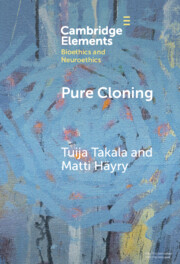Refine search
Actions for selected content:
619 results
4 - Transformation
- from Part II - Working Environments: Extraction and the Making of Place
-
- Book:
- Burning Swamps
- Print publication:
- 25 September 2025, pp 134-168
-
- Chapter
- Export citation
Chapter 2 - Neuralia on Earth
-
- Book:
- The Neural Structure of Consciousness
- Published online:
- 27 July 2025
- Print publication:
- 18 September 2025, pp 35-71
-
- Chapter
- Export citation
Microanatomy and ultrastructure of the mother sporocyst of Bunocotyle progenetica (Markowski, 1936) Chabaud et Buttner, 1959 (Digenea: Hemiuroidea)
-
- Journal:
- Journal of Helminthology / Volume 99 / 2025
- Published online by Cambridge University Press:
- 01 September 2025, e98
-
- Article
- Export citation
Nutrient storage dynamics in male Mytilus coruscus: interplay of glycogen, amino acids, fatty acids, and nutritional elements (C, N, P) during reproductive development
-
- Journal:
- Journal of the Marine Biological Association of the United Kingdom / Volume 105 / 2025
- Published online by Cambridge University Press:
- 27 August 2025, e90
-
- Article
- Export citation

Selling Sexual Knowledge
- Medical Publishing and Obscenity in Victorian Britain
-
- Published online:
- 24 June 2025
- Print publication:
- 10 July 2025
-
- Book
-
- You have access
- Open access
- Export citation
Multiyear outdoor mesocosm experiment reveals differences in Butomus umbellatus genotype growth and response to herbicides
-
- Journal:
- Invasive Plant Science and Management / Volume 18 / 2025
- Published online by Cambridge University Press:
- 23 June 2025, e21
-
- Article
-
- You have access
- Open access
- HTML
- Export citation
Disturbed areas promote more parental care and less nesting preference in females of broad-snouted caiman (Caiman latirostris) – ADDENDUM
-
- Journal:
- Animal Welfare / Volume 34 / 2025
- Published online by Cambridge University Press:
- 11 June 2025, e36
-
- Article
-
- You have access
- Open access
- HTML
- Export citation
17 - Bioethics, Reproduction, and Extending Life
- from Part III - Health, Workforce, and Innovation: The Investments Required for a Healthy Lifespan
-
-
- Book:
- Law and the 100-Year Life
- Published online:
- 13 May 2025
- Print publication:
- 29 May 2025, pp 229-242
-
- Chapter
-
- You have access
- Open access
- HTML
- Export citation
Chapter 8 - Sex, Kinship, and Other Freedom Practices
-
-
- Book:
- The Cambridge Companion to Mary Prince
- Published online:
- 24 April 2025
- Print publication:
- 08 May 2025, pp 135-151
-
- Chapter
- Export citation
Chapter 8 - Thyroid Physiology and Early Pregnancy
-
-
- Book:
- Early Pregnancy
- Published online:
- 16 April 2025
- Print publication:
- 08 May 2025, pp 70-80
-
- Chapter
- Export citation
14 - The Legal Situation Regarding Assisted Reproduction in Iran
-
-
- Book:
- The Rule of Law in the Islamic Republic of Iran
- Published online:
- 10 April 2025
- Print publication:
- 17 April 2025, pp 414-443
-
- Chapter
- Export citation
Role of anti-Müllerian hormone in different reproductive aspects of female mammals: women, cow and mare
-
- Journal:
- Animal Health Research Reviews / Volume 24 / Issue 2 / December 2023
- Published online by Cambridge University Press:
- 24 March 2025, pp. 64-74
-
- Article
-
- You have access
- Open access
- HTML
- Export citation
Consumption of low-protein or high-fat diets during peripubertal age alter spermatozoa, testis and epididymis of pubertal rats
-
- Journal:
- Journal of Developmental Origins of Health and Disease / Volume 16 / 2025
- Published online by Cambridge University Press:
- 17 March 2025, e15
-
- Article
- Export citation
12 - Globalizing European Gender History
-
-
- Book:
- Globalizing Europe
- Published online:
- 06 March 2025
- Print publication:
- 13 March 2025, pp 181-199
-
- Chapter
- Export citation
Sexual and Reproductive Health & Rights: Advances and Setbacks
-
- Journal:
- Journal of Law, Medicine & Ethics / Volume 53 / Issue S1 / Spring 2025
- Published online by Cambridge University Press:
- 16 April 2025, pp. 66-68
- Print publication:
- Spring 2025
-
- Article
-
- You have access
- Open access
- HTML
- Export citation

Pure Cloning
-
- Published online:
- 14 February 2025
- Print publication:
- 13 March 2025
-
- Element
-
- You have access
- Open access
- HTML
- Export citation
Chapter 16 - Sexual and Reproductive Health: An Islamic Perspective
-
-
- Book:
- Contemporary Islamic Perspectives in Public Health
- Published online:
- 02 January 2025
- Print publication:
- 16 January 2025, pp 99-105
-
- Chapter
- Export citation
Reproduction and Senescence: The Meeting of Thomistic Philosophy and Modern Biogerontological Evolutionary Theories
-
- Journal:
- New Blackfriars / Volume 106 / Issue 1 / January 2025
- Published online by Cambridge University Press:
- 20 January 2025, pp. 53-68
- Print publication:
- January 2025
-
- Article
- Export citation
